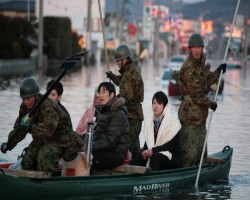Japan’s Quake, Tsunami and Nuclear Aftermath
 Japanese Red Cross
Japanese Red CrossThis past Friday, a devastating 9.0 magnitude earthquake rocked Japan, triggering a tsunami that is feared to have left more than 10,000 dead and a nuclear crisis in its wake. According to the United States Geological Survey (USGS), Friday’s earthquake was the seventh largest in recorded history, and the strongest to ever hit Japan. It was so strong, in fact, that it moved Japan’s coastline and changed the balance of the planet. Japan is “wider than it was before,” said Ross Stein, a geophysicist at the USGS.
Prime Minister Naoto Kan is calling the natural disaster the nation’s worst crisis since World War II. Amidst catastrophic damage and food and water shortages, the people of Japan must also wait and see if they will be exposed to the serious health risks posed by nuclear radiation contamination. The seawalls put in place along Japan’s northeast coastline failed to protect the Fukushima Daiichi nuclear complex from being struck by tsunami waves, in turn shutting down the generators that power the complex’s crucial cooling systems. Operators have lost the ability to cool three reactors at Daiichi and three more at another nearby complex. If a nuclear plant’s cooling system shuts down and the reactor’s core temperature rises enough for melting to occur, uranium and other dangerous radioactive matter releases into the atmosphere in the form of smoke or steam. The radioactive material then settles onto the ground and can cause nausea, fatigue, vomiting, hair loss, diarrhea and hemorrhaging, organ failure and increased incidence of mutations and cancers.
More than 180,000 people have been evacuated from the area, but 22 have already been exposed to radiation and up to 160 more might have been exposed while awaiting evacuation, said Ryo Miyake, a spokesperson from Japan’s nuclear agency. The 600 people that remain within 12 miles of the reactor site are being told to stay inside, close their doors and windows and place a wet towel over their nose and mouth as plant workers flood the hot reactors with seawater and boric acid in an effort to stop a full-scale meltdown from occurring.
Friday’s earthquake has left Daiichi plant workers exposed to twice the legal limit of radiation. Naoki Kumagai, an official at Japan’s nuclear safety agency, told the Associated Press a person at the monitoring site for an hour would get as much radiation as a plant worker typically gets in six months, but added that the levels would be much higher in the instance of a full-scale meltdown. Two hydrogen explosions over the weekend did not damage the reactors but left 11 plant workers injured and seven missing. Chief Cabinet Secretary Yukio Edano is assuring the Japanese people that the release of large amounts of radiation is “unlikely” and the current level of radiation exposure is of little risk to human health.
Dr. Ira Helfand with Physicians for Social Responsibility doesn’t take comfort in Edano’s statements. “It is not known how much radiation has been or will ultimately be released from the damaged Daiichi nuclear reactor in Japan, but as found by the National Academy of Sciences, any exposure to radiation increases a person’s risk of cancer,” she says. Nearly 2 million Japanese households were without power Sunday, and starting Monday, power will be rationed with rolling blackouts in several cities, including Tokyo.
The U.S., which gets 20% of its energy from nuclear power, is monitoring the crisis in Japan closely. With domestic nuclear plants along the coastlines of the northeast and earthquake-prone California, Senator Joe Lieberman, chairman of the Senate Homeland Security and Governmental Affairs Committee, told CBS’s Face the Nation that he doesn’t want Americans to have to fear a similar situation. “I don’t want to stop the building of nuclear power plants, but I think we’ve got to kind of quietly, quickly put the brakes on until we can absorb what has happened in Japan as a result of the earthquake and the tsunami and then see what more, if anything, we can demand of the new power plants that are coming on line.” Congressman Edward Markey (D-MA) is calling for an end to all new nuclear plants in earthquake-prone regions, as well as stronger containment vessels and thorough safety reviews to protect existing plants from natural disasters. “The unfolding disaster in Japan must produce a seismic shift in how we address nuclear safety here in America,” he said.
White House spokesperson Clark Stevens told press Sunday that “Information is still coming in about the events unfolding in Japan, but the administration is committed to learning from them and ensuring that nuclear energy is produced safely and responsibly here in the U.S.”
Though the Fukushima plant is 40 years old, new plants installed with more modern safety technology are not enough to sway those who believe plans for nuclear plants should be abandoned and replaced with much safer renewable energy technologies like wind turbines and concentrated solar. In the meantime, the world waits in hopes that disaster is averted and Fukushima’s reactors can be cooled. “They have a window of opportunity where they can do a lot,” says Friedrich Steinhaeusler, a professor of physics and biophysics at Salzburg University and an adviser to the Austrian government on nuclear issues. “But if the heat is not brought down, the cascading problems can eventually be impossible to control. This isn’t something that will happen in a few hours. It’s days.”

